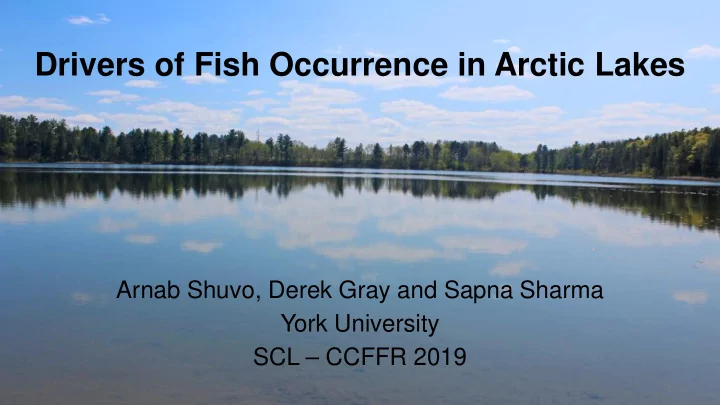

Drivers of Fish Occurrence in Arctic Lakes Arnab Shuvo, Derek Gray and Sapna Sharma York University SCL – CCFFR 2019
Background Information • Lakes along Dempster highway - Inuvik, NWT • Albedo effect • Impacts of permafrost thaw
Lakes in Inuvik with and without fish • Lakes with fish • Depauperate fish communities • Fish top predators • Lakes without fish • Benthic invertebrates - top predators • Dense community of invertebrates
Research Questions Are there differences in lake characteristics between lakes that have fish present or absent? What are the major environmental variables structuring the fish community?
Hypotheses Lake characteristics would differ between lakes with and without fish. Mean depth would be the most important variable structing the fish community.
Study Site – 28 lakes sampled
Lakes sampled for fish occurrence Ontario Broadscale Monitoring (BSM) protocol • Gill nets were set for 16-22 hours • Large gill nets caught fish > 20cm • Small gill nets caught fish < 20cm
Phantom Midge (Chaoborus) – paleoindicator of fish populations Lakes with fish • Chaoborus extirpated Lakes without fish • Chaoborus larvae - top invertebrate (e.g. Chaoborus americanus : non- migratory) Note: Chaoborus mandibles well preserved in sediment - used to infer changes in past fish populations Sweetman & Smol, 2006
Environmental Data Collection Lake morphometry: • Surface area, mean depth, and max depth Water quality: • Secchi depth, turbidity, conductivity, dissolved oxygen, pH, water temperature, and chlorophyll.
Research questions Are there differences in lake characteristics between lakes that have fish present or absent? What are the major environmental variables structuring the fish community?
Are there differences in characteristics between lakes that have fish present or absent? T-test with a Bonferroni correction (P/A) • Compares means for 2 samples • Corrects for multiple comparisons
No significant differences in lake conductivity
No significant differences in water clarity
No significant differences in lake size
There are similar environmental conditions in all sampled lakes – oligotrophic • High water clarity and low turbidity • Conductivity • Natural lakes : < 200 NTU • Gravel pit lakes: ~ 1000 NTU • Consistent water temperatures, pH, and chlorophyll
Research questions Are there differences in lake characteristics between lakes that have fish present or absent? What are the major environmental variables structuring the fish community?
Multivariate analysis tests the most significant environmental variable structuring fish communities Redundancy analysis (RDA) • Direct gradient multivariate analysis • Linear relationships between response variables - explained by set of explanatory variables. Predictor variables: Environmental variables Response variables: Fish occurrence
Fish P/A RDA – suggests surface area is the significant environmental variable structuring fish occurrence in Inuvik, NWT lakes. Explains 11.3% of variation
Species-area relationship – as area increases, more species are present (possible - greater abundances)
Low variation suggests homogenization of fish community • Homogenized fish community • Dominant species • Generalists species Heino & Mykra, 2008
Environmental Filtering - similar species are found in lakes with similar environmental conditions Environmental Filtering
Prey-predator relationships - alters fish community structure A B
Winterkill alters fish community composition by decreasing fish populations • Macroinvertebrate populations increase in the absence of fish • Juvenile Pike shift diet to small invertebrates • Occupy macroinvertebrate-rich habitats • Recolonization formerly dominated habitats
Conclusions No difference in lake characteristics between lakes that have fish present or absent Surface area is the significant environmental variable structuring fish communities in Inuvik lakes
Future work • Lake connectivity • Fish migratory rates • Trophic interactions
Acknowledgments Sapna Sharma Derek Gray Matt Teillet Lori Waters Carly Tward Jasmina Vucic Rachel Cohen Lianna Lopez Alyssa Murdoch Yvette Langille
Recommend
More recommend